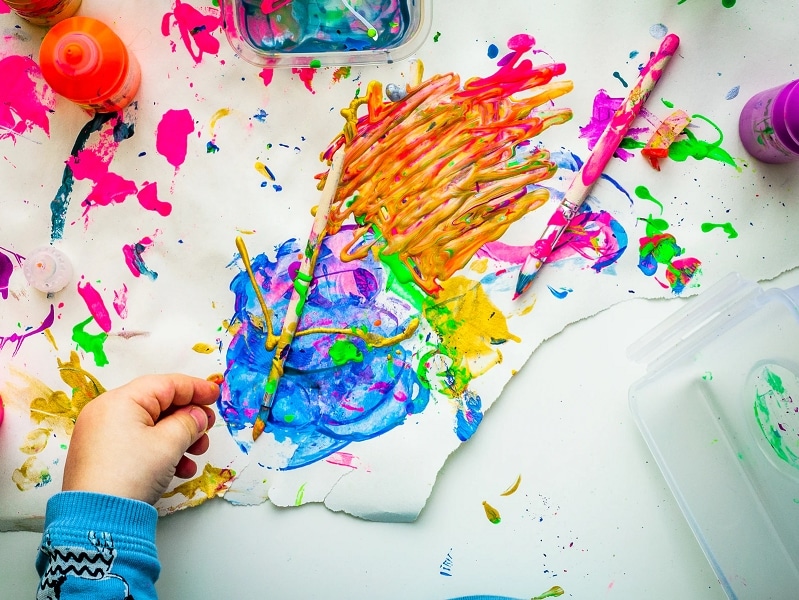Creativity isn’t only reserved for artists – it’s something we all use and can benefit from. It can even make us happier. Or is it the other way around?
Creativity and happiness are related, but it’s unclear how. Creative people seem to be happier, but positive emotions promote creativity, so it’s impossible to say with any certainty which comes first. However, what we do know is that it is possible to use different creative activities like journaling and vision boards to boost your happiness, which in turn might boost your creativity.
In this article, I’ll take a look at the interactions and links between creativity and happiness, as well as some creative exercises to make you happier.
What is creativity?
Creativity is often associated with artistic pursuits. While it’s true that writing a poem, choreographing a dance, or making a painting takes creativity, art isn’t the only place to show imagination and innovation.
Creativity plays an important role in problem-solving in different disciplines from maths and technology to linguistics. If you’ve ever done the puzzle of connecting nine dots with four lines without lifting the pencil, or any other brain teaser, or even figured out the best placement for the furniture in your living room, you’ve used creative problem-solving.
In general, creativity involves producing original and novel ideas, so it’s no wonder that creativity is a desirable trait. For all the talk about schools stifling creativity and independent thought, I constantly hear my colleagues complimenting students on their creativity.
And when you look at the people we celebrate, like entrepreneurs and artists, creativity really seems to be the way forward.
But can creativity also make you happier?
Are creative people happier?
In short, yes – creative people really do seem to be happier.
Let’s elaborate on that a little. For example, a 2014 study among university students found a significant relationship between creativity and subjective, emotional, psychological, and social well-being.
In fact, creativity was found to be a more effective predictor of subjective well-being than self-efficacy, which is also closely related to well-being and happiness.
A recent experimental study, published in July 2021, showed that participants who undertook a creativity priming task that required them to recall three situations where they had behaved creatively before completing a creativity task, reported a higher level of subjective well-being after the task than the control group.
The same study found that self-rated creativity has a positive relationship with subjective well-being in both young adults and working adults.
According to a 2015 report from the UK, people with creative occupations like town planners, architects, and graphic designers showed higher levels of well-being compared to those with non-creative professions like bankers, insurance agents, and accountants.
(Disclaimer: this does not mean that accountants can’t be creative, please do not come after me.)
Creativity can help people find light in the darkest of situations. According to a 2006 study conducted on stage I and II breast cancer patients, participation in the creative arts therapy intervention enhanced psychological well-being by decreasing negative emotional states and enhancing positive ones.
One of the ways in which creativity enhances happiness is through problem-solving. The authors of a 2019 article suggest that creative individuals tend to be better problem-solvers, which in turn lowers their stress levels and promotes happiness.
Are happier people more creative?
As with most things in psychology, it’s not entirely clear which came first – happiness or creativity. For every study showing that creativity enhances well-being, there is a study showing that well-being enhances creativity.
For example, a 2015 study showed that people are more creative on days when they experienced more positive emotions. In the study, over 600 young adults kept a diary for 13 days, recording both their creativity and positive and negative emotions.
Creativity was found to be the highest on days with high-activation positive emotions like feeling excited, energetic, and enthusiastic. Medium- and low-activation emotional states like happiness and relaxation were also beneficial for creativity, just not as strongly.
Similarly, according to a 2005 study that also used a diary method, positive affect is positively related to creativity at work.
A 2014 experimental study found that people performed better in a creativity task when they were in an experimentally induced positive mood.
The broaden-and-build theory helps to explain why happiness promotes creativity. The theory posits that positive emotions broaden one’s awareness and encourage new, exploratory thoughts and actions. Positive states like joy and hope motivate people to explore and accept new information which can improve flexible thinking and creativity.
Positive emotions also make people feel safe and secure, which makes them more likely to think divergently without fear, and more open to changes.
Creative exercises to make you happier
Creativity and happiness have a complex relationship and it’s not entirely clear which is the chicken and which is the egg in this scenario. However, what is clear is that they are related, and engaging in creative pursuits will likely do more good than harm.
If you’re looking to boost your creativity, happiness, or both, here are four creative exercises you can try out.
1. Make a vision board
A vision board is a visual representation of your goals or values. It can serve as motivation, inspiration, or a reminder to keep working toward the future you want.
There is no right way to make a vision board. For a very simple one, get a cork message board and pin postcards, magazine cutouts, pictures, and quotes that motivate and inspire you, or represent the person you would like to be. The beauty of this method is that you can add and remove pieces easily.
If you have more time and craft supplies, get some poster-sized paper and break out your glue stick and pens. The basic building blocks are the same – pictures and words that inspire you – but the result is probably more permanent. Add stickers, glitter glue, or other decorations that speak to you.
Of course, you can make a digital vision board in any editing program and set it as your desktop background.
2. Reminisce
Sometimes, it’s good to take some time and look back on your successes, and as the article I described above showed, creativity priming can have a positive effect on your happiness.
Think of times when you have been creative. If you’re stuck on a problem, remind yourself how you’ve solved problems before. Reminisce fondly of times when you were the happiest, of your favorite trips and experiences.
While it’s not good to get stuck in the past, looking back is sometimes necessary to keep going forward.
3. Write about it
You don’t need to write the next great novel to find joy in writing. Simply journaling about your day, or trying out different journaling prompts, is a great way to promote positivity and creativity in your life.
If you’re into creative writing, you can try different writing prompts, or writing challenges, like describing the sky without using the word “blue” or writing about what you see from your kitchen window for exactly five minutes.
If you have a friend to grab and are looking for some laughs, try out any variation of the one-sentence activity, where you take turns to add one sentence to a story.
4. Dance like no one’s watching
I might be a bit biased because dance is probably my favorite art form, but sometimes the best thing you can do is dance your heart out.
You don’t need to know any specific steps or movements, or even have rhythm (I sure don’t and I’ve been taking lessons for a few years now). Just put on your favorite music and move your body.
If you have no idea how to start, try looking up Just Dance videos on YouTube and following them, or playing the game if you have it.
Or, if you have fond memories of choreographing dances to Britney Spears’ songs as a kid, why not give it another go? It’s your living room and you can do whatever you want!
If nothing else, dance counts as exercise, which is already good for both your physical and mental health.
Wrapping up
Creativity and happiness have a complicated relationship and it’s not entirely clear if one causes the other. However, it is clear that creativity is something you can benefit from both problem-solving and happiness-wise, and in turn, happiness can boost creativity. What’s more, you can stimulate your creativity and happiness with some simple exercises, so you don’t have to sit around waiting for inspiration to strike!
What are your favorite ways to be creative? And do you feel happier when you’re being creative? Or does being in a happy mood make you excited to be more creative? I’d love to learn about it in the comments below!

